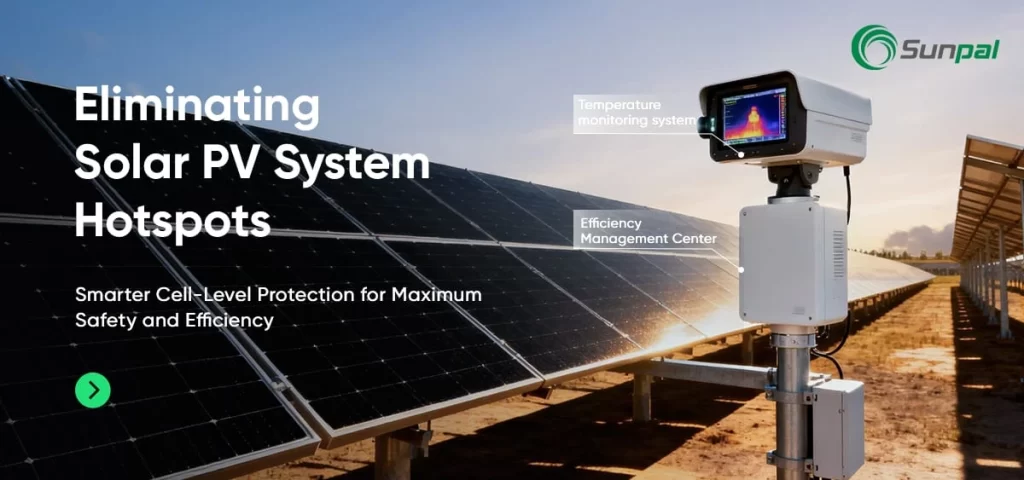
Hotspots are the silent performance killers of photovoltaic systems. For developers and EPCs pursuing high-efficiency solar projects, even a small temperature spike can mean measurable output loss, warranty claims, or premature module failure. Today's leading solar manufacturers—including Sunpal—are adopting cell-level protection technologies to eliminate hotspots and deliver safer, longer-lasting, and more bankable solar power systems.
The Hidden Cost of Solar Hotspots
Hotspots occur when part of a PV cell becomes electrically overstressed—typically from uneven irradiation, soiling, or microcracks. The affected area heats up, sometimes reaching 150°C, while the rest of the module remains cool. This localized overheating accelerates encapsulant browning, interconnect corrosion, and cell degradation, leading to long-term performance losses.
According to field data from IEA PVPS, modules affected by hotspots can lose up to 10–15% of their annual yield and face a 30% higher failure probability over a 25-year lifecycle.
Chart 1: Hotspot Temperature vs. Power Loss (%)

In large-scale projects, even minor degradation compounds across thousands of modules. The result? Reduced system efficiency, lower ROI, and increased O&M costs—all of which solar asset managers aim to avoid.
Why Do Hotspots Form? Understanding the Root Triggers
Before prevention, comes diagnosis. Common causes of hotspot formation include:
- Cell mismatch from uneven manufacturing tolerances or aging.
- Partial shading caused by trees, debris, or nearby structures.
- Bypass diode failure, which prevents current from flowing safely around shaded cells.
- Thermal cycling stress from frequent temperature fluctuations.
A critical insight: hotspots rarely result from a single factor. They usually arise from the interaction of cell defects and electrical mismatch, emphasizing the need for module-level design precision and proactive system maintenance.
Rethinking Protection: The Shift to Cell-Level Defense
Traditional modules relied on string-level bypass diodes—a reactive approach that only minimized damage after a hotspot occurred.
Today, Sunpal and other innovators are moving protection to the cell level, enabling prevention before degradation begins.
Core Technologies Driving Cell-Level Protection:
- Integrated Micro-Bypass Diodes: Embedded within sub-cells to instantly reroute current and suppress local heating.
- Half-Cut and Multi-Busbar Cells: Reduce resistive losses by shortening current paths, improving thermal uniformity.
- N-Type TOPCon and HJT Cells: Offer lower susceptibility to LID and better thermal stability under stress.
- AI-Driven Monitoring Systems: Detect abnormal I-V signatures and predict potential hotspot zones before physical damage occurs.
Chart 2: Conventional vs. Cell-Level Protection Comparison
| Protection Type | Activation Level | Temperature Control | Efficiency Retention | Maintenance Need |
| String Diodes | Module | Reactive | 85–88% | Hoch |
| Cell Micro-Diodes | Zelle | Preventive | 92–96% | Niedrig |
| AI Predictive | System | Preventive | 97–99% | Very Low |
This transition represents a paradigm shift from passive protection to intelligent prevention, aligning with the industry's move toward smart PV systems and digital O&M ecosystems.
Engineering Strategies to Keep Solar Modules Cool
Advanced technology must be complemented by robust design and operation practices. Effective engineering strategies include:
- Optimized String Layouts – Balance electrical loads to minimize current concentration.
- High-Thermal-Conductivity Encapsulants – Improve heat dissipation from localized stress points.
- Precision Soldering and Interconnection – Reduce contact resistance and potential heat buildup.
- Routine Infrared Thermography – Identify early-stage hotspots during maintenance checks.
- Smart Cleaning Schedules – Eliminate shading from dust accumulation, a frequent hotspot trigger in utility PV farms.
Chart 3: Hotspot Prevention Workflow — Design to O&M

Sunpal implements these measures across its manufacturing and EPC solutions, ensuring temperature-resilient PV systems from cell fabrication to field deployment.
Case Study: Hotspot Mitigation in Real-World PV Projects
In 2024, a 5 MW solar farm in Southeast Asia equipped with Sunpal N-type TOPCON 720W modules and cell-level bypass protection reported impressive operational results after one year of data collection:
- Average module temperature drop: 18°C compared to conventional mono-PERC modules.
- Annual yield improvement: 3.7%.
- O&M inspection time reduced: 22% through AI-assisted thermography analytics.
These measurable improvements prove that cell-level design enhancements not only prevent physical damage but also deliver quantifiable performance gains—a decisive factor for investors seeking lower Levelized Cost of Energy (LCOE).
FAQ: Common Questions About Solar PV Hotspots
Q1: What causes a solar hotspot in PV systems?
A hotspot forms when part of a solar cell faces higher resistance—often from shading, cracks, or soldering issues—causing it to heat up rapidly.
Q2: How can operators detect hotspots?
Use infrared thermography or drone-based thermal inspections to identify abnormal heat zones. Advanced plants also deploy smart monitoring with real-time data analytics.
Q3: Are hotspots reversible?
No. Once a hotspot damages cell material, degradation is irreversible. Early detection and preventive engineering are the only effective solutions.
Q4: What is the best way to prevent hotspots?
Adopt cell-level protection designs, multi-busbar N-type modules, and AI-driven O&M systems for predictive prevention.
Q5: How does Sunpal mitigate hotspot risks?
Sunpal integrates cell-level bypass diodes, advanced encapsulation materials, and thermal testing protocols to ensure maximum reliability and performance stability.
Future Outlook: Smarter, Cooler, More Resilient PV Systems
As the global solar industry accelerates toward terawatt-scale deployment, system reliability becomes just as vital as efficiency. The next decade will see:
- Self-diagnosing modules capable of automatic current rerouting.
- Nanocoatings that reflect excess heat while maintaining high light absorption.
- AI-integrated O&M platforms predicting faults before they affect yield.
Sunpal continues to lead this transformation, developing PV solutions that combine smart intelligence, thermal resilience, and high-efficiency cell architectures. These innovations redefine what it means to deliver truly bankable solar technology in a warming world.
Conclusion — Redefining Reliability at the Cell Level
Hotspot elimination is no longer a maintenance afterthought—it's a design imperative for the modern solar industry. By addressing heat generation directly at the cell level, manufacturers can deliver safer, more durable, and higher-yielding PV systems.
For Sunpal, that mission translates into continuous R&D, precision manufacturing, and real-world validation—ensuring every module is built not just to capture sunlight, but to control heat, preserve performance, and extend system life.
